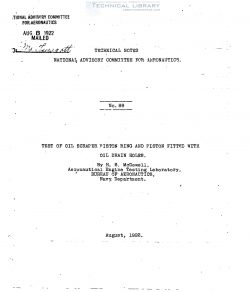naca-tn-88
- Version
- 199 Downloads
- 1.04 MB File Size
- 1 File Count
- November 3, 2016 Create Date
- November 3, 2016 Last Updated
National Advisory Committee for Aeronautics, Technical Notes - Test of Oil Scraper Piston Ring and Piston Fitted With Oil Drain Holes

The tests herewith reported were undertaken to determine
whether or not a properly located and pr0perly designed oil-
scraper piston ring, installed on a piston provided with oil drain
holes of sufficient area, would prevent the excessive oiling of
the Liberty engine, particularly with the engine run at idling
speed with full oil pressure.
The Liberty engine, when eQuipped with production rings,
installed as designed and operated at full speed at the designed
oil pressure of 50 lb. per SQ.in., oils up and throws dense
clouds of black oil smoke out of the exhaust ports even when oper—
ated with a carburetor setting so lean that the mixture periodi— ‘
cally back—fires through the carburetor. For this reason a carbu—
retor setting cannot be obtained by observation of the exhaust,
as it has a smokey, over—rich appearance at all settings. When
it is attempted to idle an engine eguipped as above, the oil pump—
ing is so bad that, after from five to fifteen minutes‘ Operation
at idling speed, oil commences to run out of the exhaust ports
and the engine must be opened up periodically in order to clean
out the spark plugs and keep them functioning.
In order to reduce this oiling, holes were drilled in
the oil pressure relief valve so that the pressure, under which
the oil is fed to the bearings,-is reduced from the designed
value of 50 lb. per sq.in. to from 30 to 35 lb. per sq.in. at full
speed. An engine with the oil pressure so regulated does not oil
up as badly, as the original production engine and can be idled
for much longer periods before oil is pumped out of the exhaust
ports and the spark plugs fouled, but, even so, the course of an
airplane eQuipped with this engine can be traced for over an>
eighth of a mile by the black oil smoke left floating behind.
Following the practice obtaining in automobile engines,
the use of an oil pressure relief valve whose.qpening is regulated
by the manifcld vacuum was suggested. This method is similar to
that mentioned in paragraph 3, in that the oil pumping is reduced
by decreasing the amount of oil fed to the bearings (and, hence,
to the cylinder walls) by reduction of the oil pressure, and dif-
fers from the former only in that, as the engine speed is reduced
by closing of the throttle, the oil pressure is decreased in di—
rect proportion to the increase in vacuum attendant upon the
throttle closure.
| File | Action |
|---|---|
| naca-tn-88 Test of Oil Scraper Piston Ring and Piston Fitted With Oil Drain Holes.pdf | Download |

Comment On This Post